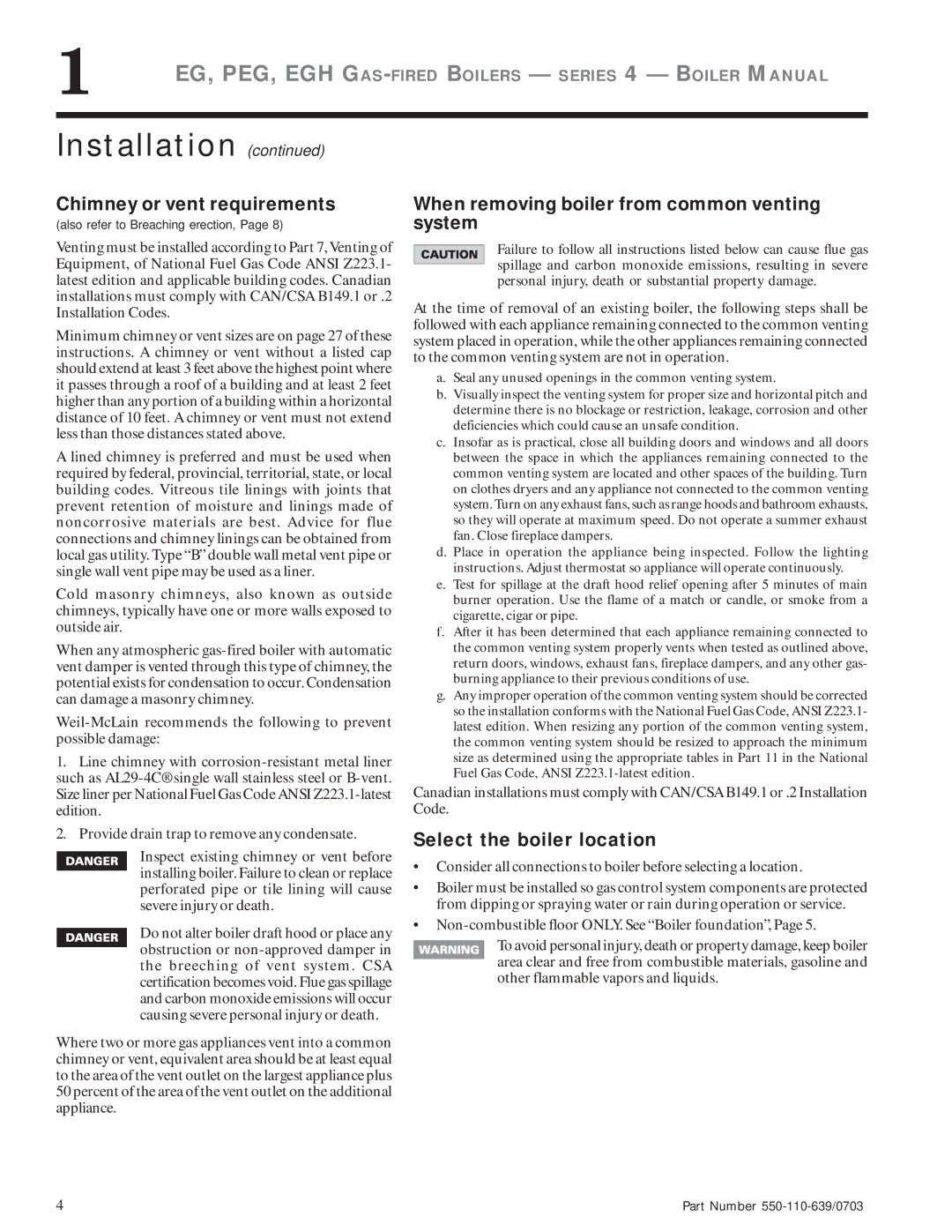Installation (continued)
Chimney or vent requirements
(also refer to Breaching erection, Page 8)
Venting must be installed according to Part 7,Venting of Equipment, of National Fuel Gas Code ANSI Z223.1- latest edition and applicable building codes. Canadian installations must comply with CAN/CSA B149.1 or .2 Installation Codes.
Minimum chimney or vent sizes are on page 27 of these instructions. A chimney or vent without a listed cap should extend at least 3 feet above the highest point where it passes through a roof of a building and at least 2 feet higher than any portion of a building within a horizontal distance of 10 feet. A chimney or vent must not extend less than those distances stated above.
A lined chimney is preferred and must be used when required by federal, provincial, territorial, state, or local building codes. Vitreous tile linings with joints that prevent retention of moisture and linings made of noncorrosive materials are best. Advice for flue connections and chimney linings can be obtained from local gas utility. Type “B” double wall metal vent pipe or single wall vent pipe may be used as a liner.
Cold masonry chimneys, also known as outside chimneys, typically have one or more walls exposed to outside air.
When any atmospheric gas-fired boiler with automatic vent damper is vented through this type of chimney, the potential exists for condensation to occur. Condensation can damage a masonry chimney.
Weil-McLain recommends the following to prevent possible damage:
1.Line chimney with corrosion-resistant metal liner such as AL29-4C® single wall stainless steel or B-vent. Size liner per National Fuel Gas Code ANSI Z223.1-latest edition.
2.Provide drain trap to remove any condensate.
Inspect existing chimney or vent before installing boiler. Failure to clean or replace perforated pipe or tile lining will cause severe injury or death.
Do not alter boiler draft hood or place any obstruction or non-approved damper in the breeching of vent system. CSA certification becomes void. Flue gas spillage and carbon monoxide emissions will occur causing severe personal injury or death.
Where two or more gas appliances vent into a common chimney or vent, equivalent area should be at least equal to the area of the vent outlet on the largest appliance plus 50 percent of the area of the vent outlet on the additional appliance.
When removing boiler from common venting system
Failure to follow all instructions listed below can cause flue gas spillage and carbon monoxide emissions, resulting in severe personal injury, death or substantial property damage.
At the time of removal of an existing boiler, the following steps shall be followed with each appliance remaining connected to the common venting system placed in operation, while the other appliances remaining connected to the common venting system are not in operation.
a.Seal any unused openings in the common venting system.
b.Visually inspect the venting system for proper size and horizontal pitch and determine there is no blockage or restriction, leakage, corrosion and other deficiencies which could cause an unsafe condition.
c.Insofar as is practical, close all building doors and windows and all doors between the space in which the appliances remaining connected to the common venting system are located and other spaces of the building. Turn on clothes dryers and any appliance not connected to the common venting system. Turn on any exhaust fans, such as range hoods and bathroom exhausts, so they will operate at maximum speed. Do not operate a summer exhaust fan. Close fireplace dampers.
d.Place in operation the appliance being inspected. Follow the lighting instructions. Adjust thermostat so appliance will operate continuously.
e.Test for spillage at the draft hood relief opening after 5 minutes of main burner operation. Use the flame of a match or candle, or smoke from a cigarette, cigar or pipe.
f.After it has been determined that each appliance remaining connected to the common venting system properly vents when tested as outlined above, return doors, windows, exhaust fans, fireplace dampers, and any other gas- burning appliance to their previous conditions of use.
g.Any improper operation of the common venting system should be corrected so the installation conforms with the National Fuel Gas Code, ANSI Z223.1- latest edition. When resizing any portion of the common venting system, the common venting system should be resized to approach the minimum size as determined using the appropriate tables in Part 11 in the National Fuel Gas Code, ANSI Z223.1-latest edition.
Canadian installations must comply with CAN/CSA B149.1 or .2 Installation Code.
Select the boiler location
•Consider all connections to boiler before selecting a location.
•Boiler must be installed so gas control system components are protected from dipping or spraying water or rain during operation or service.
•Non-combustible floor ONLY. See “Boiler foundation”, Page 5.
To avoid personal injury, death or property damage, keep boiler area clear and free from combustible materials, gasoline and other flammable vapors and liquids.

